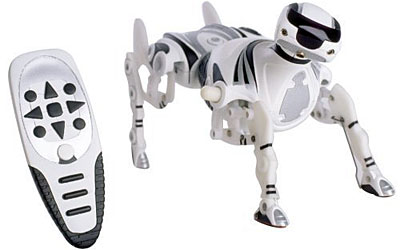Robopet
Fusion of technology and personality from Wowwee with sound and motion sensors that enable robotic pet to respond to sound and movement
 Robotic pet walks, sits, jumps, and gets up if it falls over. Features multiple functions with an easy-to-use remote control, multiple vision systems with color recognition, and fully automated demo modes. Realistic movements include walking, running, sitting, and lying down. Emits digital animal sounds including barking, whimpering, growling, and panting. Wow-wee's Robo Pet interacts with the environment. Sound and motion sensors enable response to sounds and movement. Robopet responds to positive and negative reinforcement.
Robotic pet walks, sits, jumps, and gets up if it falls over. Features multiple functions with an easy-to-use remote control, multiple vision systems with color recognition, and fully automated demo modes. Realistic movements include walking, running, sitting, and lying down. Emits digital animal sounds including barking, whimpering, growling, and panting. Wow-wee's Robo Pet interacts with the environment. Sound and motion sensors enable response to sounds and movement. Robopet responds to positive and negative reinforcement.
Robotic pets have come a long way since their introduction in the late 1990s, when simple toys like Tamagotchis or robotic dogs with limited movements were all the rage. Advances in artificial intelligence, sensor technology, and materials science have made modern robotic pets almost lifelike in their movements and interactions. Today's robotic pets can recognize voices, respond to touch, and even mimic the behaviors of real animals, like purring, barking, or wagging their tails. Some advanced models have "emotions," learning capabilities, and can interact with other smart devices. These toys not only entertain but also educate, teaching children about animal care, technology, and programming. They are also used in therapeutic settings to provide comfort and companionship to the elderly or those unable to care for real pets.
